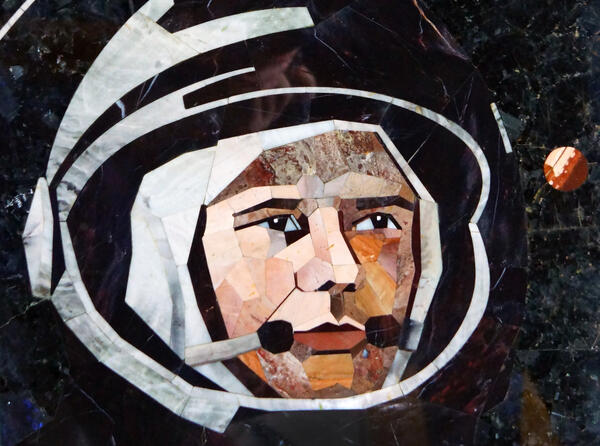In the mid-1960s, a stonecutter and jeweler of the Sverdlovsk factory “Russkiye Samotsvety” (Russian Gemstones), Vladimir Bakulin created a panel depicting the first Soviet cosmonaut Yuri Gagarin. The dark background of the work symbolizes the space itself. The author used the Florentine mosaic technique for the panel: individual pieces of multi-colored ornamental stones are pierced together so tightly that the gaps between them are almost invisible.
Florentine mosaic appeared in Italy during the Renaissance. It was distinguished by realistic images: genre scenes, faces of saints, still lifes with flowers and fruits. Such works were brought to Russia in the 18th century, during the reign of Empress Elizabeth of Russia. Using them, the Ural craftsmen learned to create these types of works, and it was possible to cover with mosaic not only flat surfaces, but also three-dimensional objects.
Vladimir Bakulin developed an interest in the Florentine technique in the mid-1960s. By that time, he had already graduated from the Ural College of Applied Arts in Nizhny Tagil and got a job at the Russkiye Samotsvety factory. Bakulin created his first mosaic in 1964. He made a portrait of the Cuban revolutionary Fidel Castro using mined at the Revnevaya Mount deposit red and variegated Orsk jasper, white cacholong and blue lapis lazuli.
Later, the artist created images of Soviet public officials — Felix Dzerzhinsky and Yakov Sverdlov. He used another type of mosaic — the Russian one, which implied using stone of the same type. For these works, the artist chose marble. The public saw portraits of Dzerzhinsky and Sverdlov at the first zonal exhibition “The Socialist Urals”. Both ordinary spectators and professional stonecutters spoke highly about them.
In 1967, at an exhibition in Perm, Vladimir Bakulin presented another mosaic work — the panel “Cosmonaut”. After that, the artist no longer created major works using this technique and took up stone-cutting art: he carved vases, bowls, boxes and other objects from stone.
In 1975, Bakulin was appointed senior artist of the Russkiye Samotsvety Factory. Of all the stones, he preferred to work with malachite, jasper and rhodonite.
Florentine mosaic appeared in Italy during the Renaissance. It was distinguished by realistic images: genre scenes, faces of saints, still lifes with flowers and fruits. Such works were brought to Russia in the 18th century, during the reign of Empress Elizabeth of Russia. Using them, the Ural craftsmen learned to create these types of works, and it was possible to cover with mosaic not only flat surfaces, but also three-dimensional objects.
Vladimir Bakulin developed an interest in the Florentine technique in the mid-1960s. By that time, he had already graduated from the Ural College of Applied Arts in Nizhny Tagil and got a job at the Russkiye Samotsvety factory. Bakulin created his first mosaic in 1964. He made a portrait of the Cuban revolutionary Fidel Castro using mined at the Revnevaya Mount deposit red and variegated Orsk jasper, white cacholong and blue lapis lazuli.
Later, the artist created images of Soviet public officials — Felix Dzerzhinsky and Yakov Sverdlov. He used another type of mosaic — the Russian one, which implied using stone of the same type. For these works, the artist chose marble. The public saw portraits of Dzerzhinsky and Sverdlov at the first zonal exhibition “The Socialist Urals”. Both ordinary spectators and professional stonecutters spoke highly about them.
In 1967, at an exhibition in Perm, Vladimir Bakulin presented another mosaic work — the panel “Cosmonaut”. After that, the artist no longer created major works using this technique and took up stone-cutting art: he carved vases, bowls, boxes and other objects from stone.
In 1975, Bakulin was appointed senior artist of the Russkiye Samotsvety Factory. Of all the stones, he preferred to work with malachite, jasper and rhodonite.



